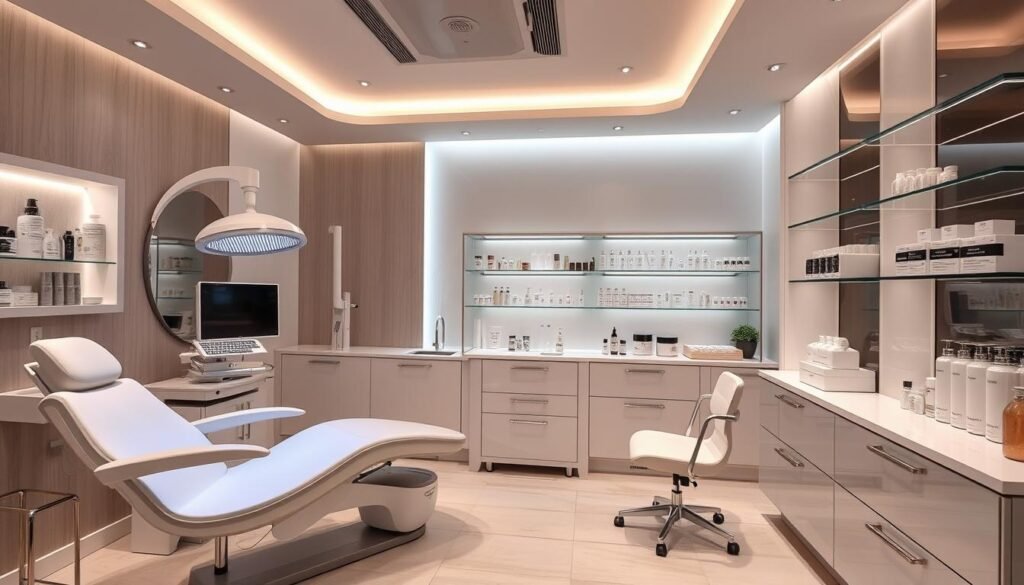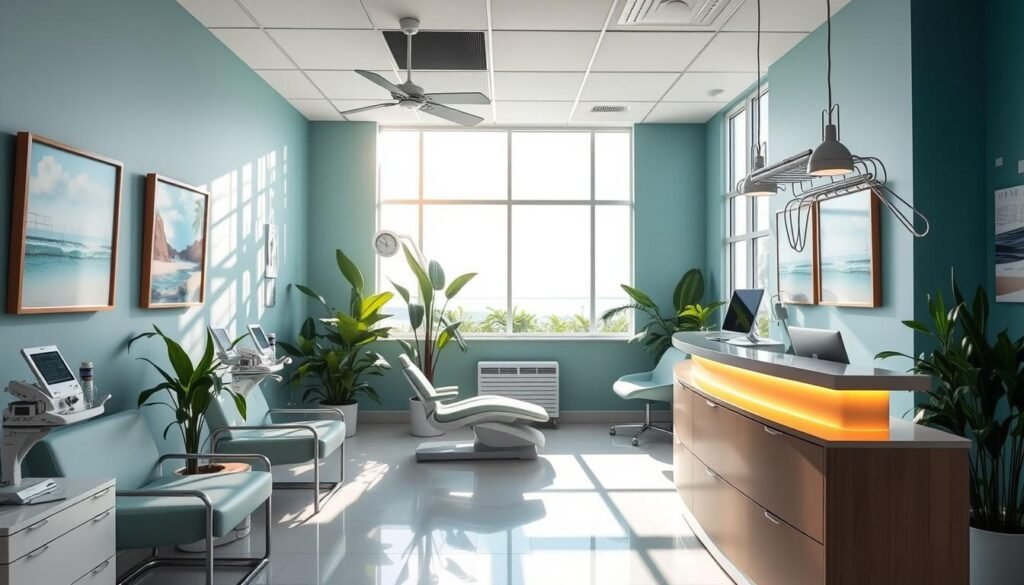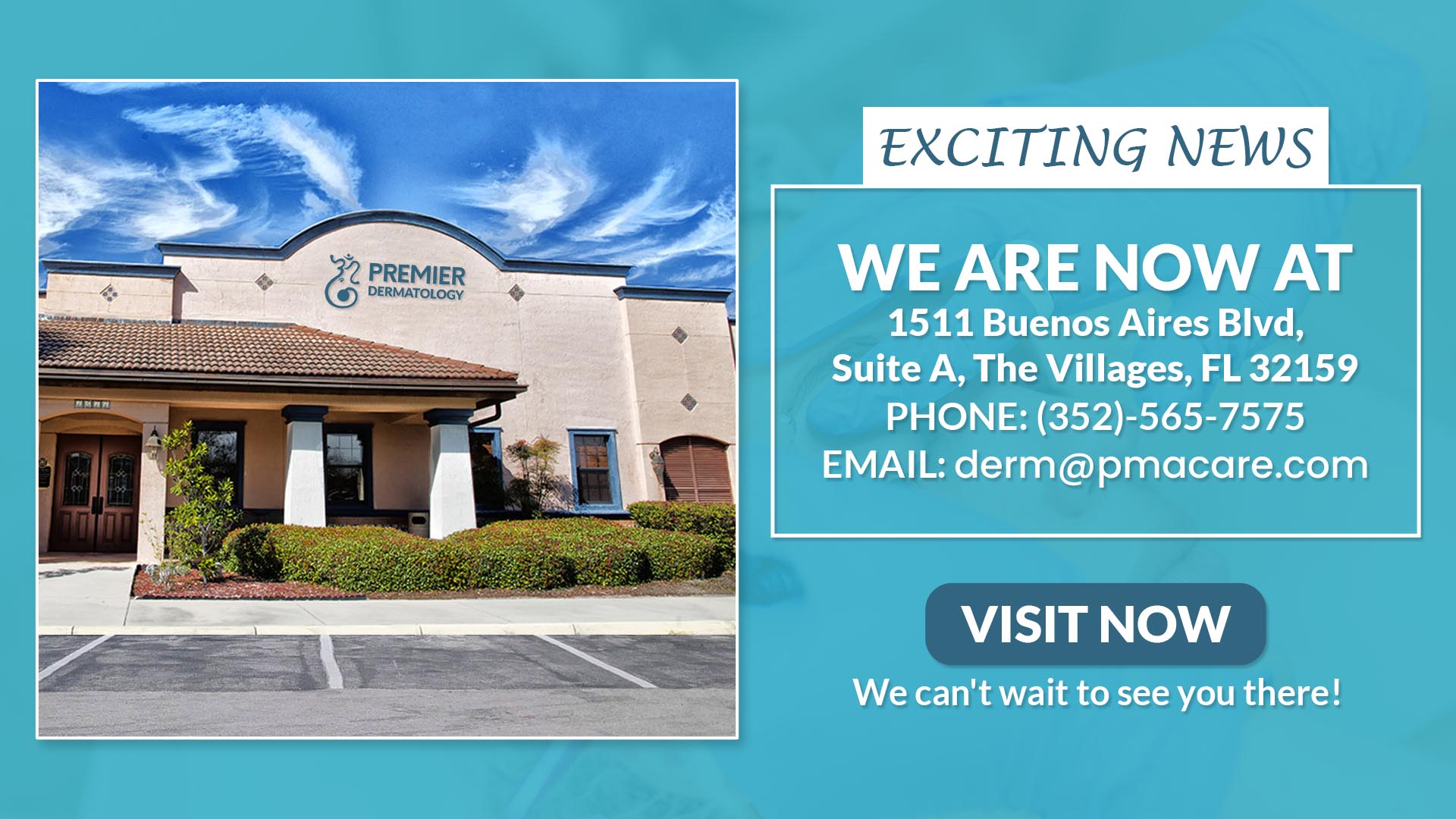Every time I look in the mirror, I see something different about my skin. Those small growths on my face have always made me curious and sometimes concerned. Understanding facial moles, skin tags, and other skin developments isn’t just about appearance—it’s about our health and confidence.
Growth on face can trigger anxiety and questions. From harmless moles to potentially concerning skin tags, our skin tells a unique story about our health. This guide will help you navigate the complex world of facial growths, providing insight into what’s normal and what might require professional attention.
Our mission is to demystify these skin changes. We offer clear, compassionate guidance about identifying, understanding, and managing various skin conditions that might emerge on your face.
Key Takeaways
- Understanding different types of facial growths is key for skin health
- Not all skin changes indicate serious medical conditions
- Regular skin monitoring can help detect issues early
- Professional dermatological consultation provides precise diagnosis
- Skin changes can be influenced by hormonal, genetic, and environmental factors
- Preventive skincare can minimize unwanted skin growths
Understanding Different Types of Facial Growth
Our skin is a complex organ that can develop various types of growths throughout our lifetime. Understanding these dermatological conditions helps us distinguish between normal and potentially concerning skin abnormalities.
Common Types of Skin Lesions
Skin lesions come in many forms, each with unique characteristics. Here are some typical types:
- Moles: Usually benign, circular or oval-shaped growths
- Skin tags: Small, soft skin protrusions often found in skin folds
- Warts: Rough, raised growths caused by human papillomavirus (HPV)
- Dermatofibromas: Small, firm skin bumps more common in women
Identifying Normal vs Abnormal Growth
Not all skin lesions are cause for alarm. Normal growths typically have consistent color, smooth borders, and remain unchanged. Abnormal skin abnormalities might display:
- Irregular shape
- Changing size or color
- Asymmetrical borders
- Bleeding or itching
When to Seek Medical Attention
Certain signs indicate you should consult a dermatologist about skin lesions. Pay attention to growths that:
Suddenly appear, change rapidly, or show unusual characteristics.
Atypical moles larger than half an inch, with uneven coloration or irregular edges, need professional evaluation. This is to rule out skin cancer risks.
Growth on Face: Causes and Risk Factors
Understanding growth on the face involves looking at many factors. These include genetics, the environment, and health conditions. These factors can lead to issues like acne, skin tags, and more.
- Sun exposure and UV radiation
- Hormonal changes
- Genetic inheritance
- Age-related skin transformations
- Metabolic health conditions
Some health conditions raise the risk of facial growths. For example, people with type 2 diabetes or high insulin levels often get skin tags. About 50% of people over 40 get skin growths due to aging.
“Understanding your skin’s unique characteristics is the first step in effective management and prevention of facial growths.”
| Growth Type | Primary Risk Factors | Prevalence |
|---|---|---|
| Skin Tags | Diabetes, Obesity | Common after age 40 |
| Acne | Hormones, Genetics | 80% of people aged 11-30 |
| Cherry Angiomas | Age, Genetics | Most common after 30 |
Being in the sun for too long increases risk. Up to 90% of nonmelanoma skin growths come from UV radiation. This shows why protecting your skin and getting regular check-ups are key.
Medical Conditions That Cause Facial Growth
It’s important to know what medical conditions cause facial growths. Our bodies can grow skin abnormalities due to hormones, genes, and the environment.
Facial growths come from complex interactions in our bodies. They can tell us a lot about our health.
Hormonal Imbalances and Their Impact
Hormonal changes can cause skin problems. Here are some key points:
- Polycystic Ovary Syndrome (PCOS) affects 6-10% of women
- Approximately 70% of PCOS patients experience hirsutism
- Androgen levels directly influence skin and hair growth patterns
Genetic Predispositions
Genetics play a big role in facial growths. Some people are more likely to get certain skin problems, like acne.
Environmental Influences
Things outside of us can also change our skin. Pollution, UV rays, and our lifestyle can make skin problems worse.
“Our skin reflects both internal health and external environmental interactions.” – Dermatology Research Institute
With hirsutism affecting nearly 10% of women in the United States, it’s key to understand these conditions for better skin health.
Professional Treatment Options
Dealing with skin issues needs a detailed plan. Our professional treatments offer advanced solutions for different facial growths and warts. They provide targeted and effective ways to help patients.

- Cryosurgery for precise removal of skin growths
- Laser therapy for targeted treatment
- Chemical peels to address multiple skin conditions
- Microneedling for skin rejuvenation
Our treatments focus on specific skin challenges:
- Cryotherapy: Uses liquid nitrogen to remove warts and small skin abnormalities
- Laser Resurfacing: Treats sun damage and improves skin texture
- Surgical Excision: Removes complex or potentially cancerous growths
“Precision and expertise are key in treating complex skin conditions” – Dermatology Specialists
Each treatment is chosen based on the skin issue’s details. This ensures the best approach for each patient. We suggest talking to a board-certified dermatologist to find the right treatment for your skin concerns.
At-Home Management Techniques
Managing facial skin issues like acne, skin tags, and rashes needs a good home care plan. Daily skincare and prevention are key to keep your skin healthy and prevent unwanted growths.
Daily Skincare Routine
Having a regular skincare routine is essential for tackling skin problems. The American Academy of Dermatology suggests:
- Wash your face twice a day with a gentle cleanser
- Use lukewarm water to avoid skin irritation
- Pat your skin dry instead of rubbing it
- Apply a noncomedogenic moisturizer
- Use sunscreen with at least SPF 30
Natural Remedies
There are natural ways to help your skin:
- Coconut oil has anti-inflammatory properties
- Drink more water for hydration
- Eat probiotic-rich foods
- Try turmeric masks for skin benefits
Preventive Measures
Preventing skin problems means making smart lifestyle choices:
| Prevention Strategy | Benefits |
|---|---|
| Protect from sun exposure | Reduces risk of skin damage |
| Maintain balanced diet | Supports overall skin health |
| Manage stress levels | Minimizes inflammatory skin conditions |
“Healthy skin is a reflection of overall wellness” – Dermatology Experts
By using these methods, you can manage skin tags, rashes, and acne. This helps keep your skin healthy for the long term.
Surgical Removal Methods
Surgical removal is a precise way to deal with facial moles, skin tags, and warts. Our dermatologists use special techniques to treat each skin condition effectively.
Dermatologists use different surgical methods for facial growths:
- Excision for complete removal of facial moles
- Shave removal for superficial skin tags
- Electrocautery for small warts
- Mohs micrographic surgery for complex cases
Knowing about the surgery helps patients make better choices. Mohs surgery has a 99% cure rate for high-risk skin cancers. It checks every tissue margin, unlike other methods.
| Procedure Type | Best For | Recovery Time |
|---|---|---|
| Surgical Excision | Deeper facial moles and suspicious growths | 1-3 weeks |
| Electrocautery | Small warts and skin tags | 7-10 days |
| Mohs Surgery | Skin cancer and complex lesions | 2-4 weeks |
Precision is key when removing facial growths. Our skilled approach reduces scarring and aids in healing.
Before choosing surgery, patients should think about a few things:
- See a board-certified dermatologist
- Check the growth’s characteristics
- Know the possible risks
- Talk about after-care
We advise following our pre- and post-procedure guidelines. This helps get the best results and avoids complications.
Non-Invasive Treatment Solutions
Dealing with skin lesions, acne, and rashes can be tough. We know how important it is to find gentle treatments. Our goal is to help manage facial growths without surgery. We focus on non-surgical solutions to improve your skin’s look and feel.
Topical Medications for Skin Concerns
Topical medications target specific skin issues. They can help with:
- Mild acne breakouts
- Small skin lesions
- Inflammatory rashes
Prescription Creams for Advanced Care
Prescription creams are stronger than over-the-counter options. Dermatologists might suggest them for:
- Reducing inflammation
- Targeting specific skin conditions
- Healing persistent skin issues
Over-the-Counter Products for Daily Management
Many treatments don’t need a doctor’s prescription. Some key products are:
- Salicylic acid treatments for acne
- Hydrocortisone creams for minor rashes
- Healing ointments for skin lesions
Always talk to a healthcare professional before starting any new skin treatment.
We believe in personalized care. We know everyone’s skin is different. We suggest talking to a dermatologist to find the best treatment for you.
Lifestyle Changes for Prevention
Keeping your skin healthy means more than just using products. Our daily habits play a big role in how our skin looks. Making smart lifestyle choices can help prevent skin problems and keep our skin looking great.
Protecting your skin from the sun is key. Use a broad-spectrum sunscreen with SPF 30 or higher. Here are some sun protection tips:
- Apply sunscreen every two hours
- Stay out of the sun between 10 a.m. and 4 p.m.
- Wear wide-brimmed hats and protective clothing
- Find shade when the sun is strong
What you eat affects your skin too. Eating foods full of antioxidants and omega-3s is good for your skin. Try adding these to your diet:
| Food Category | Skin Benefits |
|---|---|
| Fatty Fish | Reduces inflammation, supports skin barrier |
| Green Tea | Protects against environmental skin aging |
| Dark Chocolate | Provides flavonol antioxidants |
| Olive Oil | Contains monounsaturated fats that reduce skin aging |
“Your skin reflects your overall health and lifestyle choices” – Dermatology Experts
Managing stress is also important. Regular exercise, meditation, and enough sleep help. Try to get 7-9 hours of sleep and do yoga or deep breathing to relax.
By making these lifestyle changes, we can keep our skin healthy. This reduces the chance of skin problems and keeps our skin looking good.
Dietary Considerations for Skin Health
Our diet is key in managing skin problems like acne and rashes. The foods we eat can greatly affect our skin. They can change how our skin looks and feels.
Important nutrients for skin health include:
- Antioxidant-rich foods to combat skin damage
- Omega-3 fatty acids for reducing inflammation
- Vitamins A, C, and E for skin repair
“Let food be thy medicine and medicine be thy food” – Hippocrates
Some foods are great for our skin. Eating one avocado a day for 8 weeks can make our skin more elastic. Dark chocolate with 70% cocoa has antioxidants that protect our skin.
| Food | Skin Benefits |
|---|---|
| Sweet Potato | High in Beta Carotene (Vitamin A) |
| Red Bell Pepper | 156% Daily Value of Vitamin A |
| Walnuts | Reduces Skin Inflammation |
If you have acne or other skin issues, try eating less processed sugar. Eat more foods full of nutrients. Drinking plenty of water and eating well can help keep your skin healthy.
Managing Hormonal-Related Growth
Hormonal changes can greatly affect skin health and cause growth on the face. Knowing how these changes work helps people manage their skin better.
Hormonal shifts are key in skin changes. Studies show important links between hormones and skin health:
- Estrogen decline makes skin thinner and less elastic
- Testosterone boosts sebum production
- High cortisol can cause skin inflammation
PCOS-Related Growth
Polycystic ovary syndrome (PCOS) is a big hormonal issue for skin health. About 6-10% of women have PCOS, leading to unique skin problems.
| PCOS Skin Manifestations | Prevalence |
|---|---|
| Hirsutism | 70% of PCOS patients |
| Acne | 50-60% of cases |
| Skin Pigmentation | 30-40% of individuals |
Menopause-Related Changes
Menopause brings big changes to the skin. Estrogen reduction leads to less elastic skin, dryness, and growth.
“Hormonal changes are not just internal processes but visible experiences that reshape our skin’s landscape.” – Dermatology Research Institute
Treatment Approaches
Dealing with hormonal skin growth needs a full plan:
- Hormonal therapy
- Targeted medical treatments
- Lifestyle changes
- Regular visits to the dermatologist
We focus on care that fits each person. Every hormonal profile needs its own approach for the best skin health.
Long-Term Care and Maintenance
Dealing with skin lesions, facial moles, and skin tags needs a long-term plan. Keeping your skin healthy is more than just occasional treatments. It’s about regular checks and care to avoid problems.
- Do monthly self-checks on facial moles and skin tags
- Keep a record of any changes in size, color, or texture of skin lesions
- Stay out of the sun too much
- Stick to a skincare routine
- See a dermatologist once a year
Professional monitoring is key as you get older. If you’ve had trouble with skin growths before, watch out even more. We focus on catching problems early and preventing them.
“Prevention is always better than cure when it comes to skin health.” – Dermatology Experts
Important parts of long-term skin care include:
- Use sunscreen with broad-spectrum protection every day
- Keep your skin moisturized
- Eat foods full of antioxidants
- Manage any health issues
- Keep stress levels down
We suggest keeping a skin health journal. It helps you track changes in skin lesions or moles. This way, you can be more involved in your skin care.
When to Visit Our Florida Clinics
Dealing with skin problems can be tough. Our Florida clinics are here to help with skin issues like warts and more. We know how important it is to get help quickly.

We have clinics all over Florida for easy access to care. Our team is dedicated to top-notch dermatology services in places like:
- Orlando
- Clermont
- The Villages
- Kissimmee
- Ocala
- Bushnell
- Belleview
Available Services at Our Locations
We have many options for treating skin conditions. Our clinics offer:
- Detailed skin exams
- Advanced diagnostic tests
- Custom treatment plans
- Personal skin health advice
Insurance and Payment Options
We know medical costs can worry you. Our team works hard to make things clear. We accept many insurance plans and have flexible payment options.
Your skin health is our priority. Let us help you find the right treatment solution.
Ready to book an appointment? Call our patient care team at +1(352) 565-7575. We’re here to help you with kindness and expertise.
Dermatological Advances in Facial Growth Treatment
The field of treating skin lesions and abnormalities is changing fast. New discoveries are leading to better, less painful ways to handle tough skin problems.
New methods for treating facial growths are making a big difference. Microneedling is one of the most exciting new techniques. It makes skin look and feel better.
- Advanced microneedling techniques can improve collagen deposition by up to 400%
- Treatments now enhance drug delivery across the skin barrier by 47%
- Minimally invasive procedures reduce recovery time and possible side effects
“The future of dermatological treatment lies in precision, personalization, and minimal invasiveness.” – Dermatology Research Institute
Research is showing great progress in growth factor therapies. Studies show big improvements in skin texture. Patients see smoother skin and fewer fine lines.
New technologies are changing what’s possible in skin care. We expect even more breakthroughs to help those with complex facial growths.
Conclusion
Understanding growth on the face is key. We need to pay close attention and get medical help early. Skin lesions can tell us a lot about our health.
We’ve looked at many ways to handle skin issues. This includes knowing risk factors and trying new treatments. Each person’s skin is different, so we need to find what works best for them.
Seeing a doctor is the best way to get help. They can give you a plan that fits your health and family history. This way, you can take care of your skin better.
It’s important to check your skin often and talk to your doctor. Knowing about changes in your skin can help you take care of it. Catching problems early is key to keeping your skin healthy.
We want to help you understand your skin better. Whether it’s small changes or big issues, we’re here for you. Our team is ready to give you the care you need, tailored just for you.




